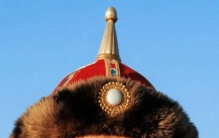天下”最老最大”生物”潘多”颤杨群接近灭亡(双语) ...
One of the largest organisms in the world, a Utah forest of genetically identical trees, is slowly being devoured by deer.
天下上最大的生物之一——犹他州的一片基因完全雷同的树林,正渐渐被鹿啃光。
The Pando quaking aspen colony, also known as the "Trembling Giant," has likely survived for thousands of years. But about 80 percent of it is in a perilous state, according to a new paper published today (Oct. 17) in the journal PLOS One.
这个“潘多”颤杨群(也被称为“发抖的伟人”)大概已生计了数千年。但17日揭橥在美国《科学公共藏书楼·综合》杂志上的一篇最新论文称,其约莫80%的树木处于伤害当中。
The trembling giant, weighing 13 million lbs. (5.9 million kilograms) and covering 106 acres ( square kilometers) of Utah’s Fishlake National Forest, consists of over 47,000 genetically identical stems that grow from a single underground parent clone.
这个“发抖的伟人”位于犹他州鱼湖国家丛林公园,重约1300万磅(约590万千克),占地约106英亩(0.42平方千米)。它由一个地下无性生殖根系上长出的4.7万株基因如出一辙的树干构成。
In this new study, a group of researchers measured the health of various parts of the forest, such as by counting the number of living versus dead trees, counting the number of new stems and tracking the feces of animals that dropped in for a bite. They found that the biggest obstacle to the strongest indicator of the forest’s health — whether new sprouts could survive — was mule deer.
在这项最新研讨中,几个研讨人员权衡了树林差别部位的安康情况,好比数一数活树与死树的数目和新长出树干的数目并追踪啃树植物的排泄物。他们发明,树林安康情况最有份量的目标就是新芽可否存活,而它的最大停滞是骡鹿。
It’s natural that the older stems are dying off, lead author Paul Rogers, the director of the Western Aspen Alliance and adjunct associate professor at Utah State University,told Live Science. What’s unnatural is that new stems aren’t growing, he said. For the past couple of decades, mule deer and cattle have been eating all the new stems that sprout from the underground mama aspen. In most areas, there’s no "young or middle-aged trees at all," he said. So the forest, to use human terms, is made up "entirely of very elderly senior citizens," Rogers said.
论文第一作者、美国西部颤杨同盟负责人、犹他州立大学兼任副教授保罗·罗杰斯在接管美国兴趣科学网页采访时称,老树枯槁死是自然而然的。他说,违背自然规律的是,新树干长不出来。在曩昔几十年里,骡鹿和牛不断在吃掉从地下颤杨母根上抽芽的全部新树苗。他说,大多数区域没有“中青年树”。罗杰斯示意,用拟人词语来讲,这片树林“完全由老年人”构成。
Rogers and his team also compared aerial photographs of the area that spanned 72 years and found that the aspen forest has been thinning. Back in 1939, the tree crowns all touched, but starting in the 1970s, "you see a lot of spaces between the trees," he said. This means that the old trees are dying and new ones aren’t coming in to fill in the gaps.
罗杰斯和他的团队还对照了该区域72年来的航拍照片,发明这片颤杨林日趋稠密。他说,在1939年时,树冠连成一片,但从上世纪70年月可以,“能够看到树与树之间有很大清闲”。这就是说,老树渐渐枯死,而新树没有长出来弥补空白。
Part of the problem is that game such as mule deer do not have natural predators in the area anymore. In the early 1900s, humans killed off most natural predators, such as wolves and grizzly bears, Rogers said. Now, most of the grounds in Pando are set aside for recreational uses like camping, where the browsers are protected from hunting. "The deer know that very early on, and they find it a safe harbor."
成绩的部份关键在于,该区域的骡鹿等植物不再有天敌。罗杰斯说,在20世纪初,人类杀死了它们的大多数天敌,好比狼和灰熊。如今,“潘多”的大部份空中被用于休闲流动,好比野营,啃食嫩枝的植物是遭到爱护不得猎杀的。罗杰斯说:“骡鹿很早就晓得这一点,它们发明那里很宁静。”
But really, "Pando is failing because of human decisions," Rogers said. "Humans control wild animals, particularly wild-game species like deer and elk."
不外,“潘多的失利,是因为人类的定夺,”罗杰斯说。“人类节制着野生植物,特别是像鹿和麋鹿如此的野生植物。”
There is one part of the trembling giant that is thriving. This area was fenced in around 2013 and within five years, thousands of stems — some 12 to 15 feet (3.6 to 4.5 m) tall — have been growing per acre, Rogers said. Here, the fence seems to be working. Half of the area that the aspen clone takes up is unfenced and easily accessible by the mule deer and cattle. Around 30 percent of the area is fenced in with an 8-foot-tall (2.4 meters) fence, Rogers said. But "the fence is not doing its job, so it’s also in a poor state," he said. "Somehow, the animals are still getting in — it’s a bit of a mystery to us," he said. He thinks the mule deer (not the cattle) are jumping it.
不外,“发抖的伟人”有一部份闹热畅旺。罗杰斯说,这块区域在2013年阁下被圈起来,五年内均匀每英亩长出了数千株树木,高约12到15英尺(3.6米到4.5米)。在那里,围栏好像施展着感化。这个颤杨根系所及的区域有一半没有围栏爱护,很轻易有骡鹿和牛进入。罗杰斯说,约莫有30%的区域用8英尺高(2.4米)的围栏围着,但他示意:“围栏没有施展感化,于是仍旧很蹩脚。”不知怎样的,植物们照样能够进来——这对我们来讲大概有点神奇。”他认为骡鹿(不是牛)跳过了围栏。
"We need to help control the animals — both deer and cattle — and give Pando a break so that it can recover," Rogers said. This can be done by culling their numbers, restricting them with properly working fences or keeping them moving out of the area, as predators traditionally did, he said.
罗杰斯说:“我们需求辅助节制这些植物——不管是鹿照样牛——让‘潘多’有机遇喘口吻以便复兴。” 他说,这能够通过削减它们的数目,用符合的围栏限定它们的流动,大概像古老的捕食者那样,让它们阔别这个区域来实现。
"We’re not talking about just the tree, but we’re talking about all the plants and animals dependent on it," Rogers said. "We can’t manage wildlife and forest independently, we have to manage them in concert and in coordination with each other."
罗杰斯示意,“我们所评论的不只是树,而是全部依靠于树生计的动植物。”“我们没法自力经管野生植物和丛林,我们必需和谐分歧。”
And the approaches that work to protect Pando could be extended to aspens around the world, he said.
而且他说,爱护潘多的这片树林的方式能够在全天下发扬。
大家都在看
-
20根肋骨同时折断?揭秘人类分娩为何最痛 哎呀,姐妹们,今天咱们聊点扎心的。生过孩子的都懂,产房里那滋味,真是谁生谁知道——宫缩一起来,就跟肚子里的零件被重新组装似的,疼得人恨不得抓着床头做引体向上。没生过的可能也听过那句“相当于同时折断20根 ... 人类之最12-18
-
雅尔塔会议的位置不是随便坐的,谁的地位更高,贡献更大一目了然 1945年雅尔塔那张合影,斯大林为何乖乖坐侧边?只因罗斯福身后那张天价账单一九四五年2月,克里米亚的寒风里,一场决定世界命运的会议刚散场。作为东道主,那个被称为“钢铁之人”的斯大林,竟然乐呵呵地坐在了侧座 ... 人类之最12-17
-
教育孩子应该了解的世界之最 教育孩子应该了解的世界之最了解“世界之最”是孩子们认识世界、拓展视野的绝佳方式。这些记录不仅有趣,更蕴含着地理、历史、生物和科技等多学科知识。以下为您梳理了多个领域的“世界之最”,帮助孩子在轻松愉快的 ... 人类之最12-15
-
他一生没写过字却用马蹄在欧亚大陆刻下人类史上最庞大的标点符号 成吉思汗:一位以草原为稿纸、以铁骑为刻刀的文明断句者1206年,斡难河源头。九脚白纛猎猎作响,风卷起苍狼图腾旗上未干的血渍。铁木真被推举为“成吉思汗”,意为“海洋般辽阔的君王”。可真正震撼历史的,并非这个 ... 人类之最12-15
-
人类最珍贵的品格是什么? 探寻人类最珍贵的品格:照亮心灵的璀璨之光在人类文明的漫漫长河中,无数品格如繁星般闪耀,它们构成了人类独特的精神世界。那么,人类最珍贵的品格究竟是什么呢?这是一个值得我们深入探讨的问题。善良——温暖世界 ... 人类之最12-13
-
一曲霓裳尽风华 京剧包拯脸谱川剧包拯脸谱秦腔包拯脸谱昆曲《牡丹亭》生媛媛扮演杜丽娘2020年10月23日,习近平总书记在给中国戏曲学院师生的回信中指出,“戏曲是中华文化的瑰宝”。瑰宝,既指奇珍异宝,又指珍贵的精神财富,还指能 ... 人类之最12-12
-
成吉思汗不是只会射雕的猛男而是人类史上最牛的创业CE0 那个让欧洲人听见名字就哆嗦、被西方史学家称为“上帝之鞭”的男人:成吉思汗!骑着蒙古马、弯弓射大雕 一路狂飙灭国四十个打到多瑙河边,吓得教皇连夜写信求和他靠的是一套超前800年的管理系统+人才机制+品牌营销+ ... 人类之最12-12
-
以军枪杀跪地投降者,内塔尼亚胡“最道德”言论,沦为国际笑话 “全世界最有道德的军队”,我以前差点就信了,直到看见那段让人心脏骤停的视频。那两声枪响,撕碎了什么那段视频,没有任何配乐,画质也谈不上高清。但它带来的窒息感,比任何恐怖片都真实。两个巴勒斯坦年轻人,面 ... 人类之最12-09
-
华沙之跪:那一刻,唤醒人类良知的深沉忏悔 在这个世界上,最动人的画面,往往不是华丽的辞藻,也不是强烈的口号,而是那些发自内心、用行动表达的真诚。二战的阴影还未散去时,欧洲的土地上弥漫着仇恨、痛苦与沉重的记忆。而在这些记忆中,有一幕,像一束穿透 ... 人类之最12-08
-
爱情之花——永恒的主题,人类最宝贵最灿烂的灵魂绿宝石 她曾迷恋丈夫的浪漫和激情,一场重病让她明白:激情型爱情是婚姻的滑稽戏。晓月把药片丢在床头柜上,发出清脆一声。她终于明白了,电影里的爱情都是骗人的,那些轰轰烈烈的“春蚕到死丝方尽”的誓言,在婚姻里只剩下 ... 人类之最12-07
相关文章
- 华沙之跪:那一刻,唤醒人类良知的深沉忏悔
- 揉耳通经络!大雪节气养生从头暖到脚
- 爱情之花——永恒的主题,人类最宝贵最灿烂的灵魂绿宝石
- “人类最惨一年”是哪一年?公元536年称第二,没人敢称第一
- 南京大屠杀:三十万冤魂的泣血呐喊,揭开人类文明最黑暗一页
- 华沙之跪:一位德国总理的忏悔与人类良知的呼唤
- 【人体奥秘04】大脑:你那1.5公斤重的“宇宙”
- 人体:宇宙间最精密的智能体
- 篝火旁的裂痕:人类社会最初阶级的诞生之路
- 人类历史上非常烧脑的5大悖论,你曾考虑过这些问题吗?
- 孔子最伟大的思想是什么
- 人类与AI的“终极屏障”,或许就藏在“此时此刻”
- 人类战争史上最离谱的5次翻盘,第4个像开了挂
- 从文艺复兴到现代,艺术史上最动人的慈颜
- “数学之王”高斯:天才少年如何用智慧改写人类科学史?
- 稻粟之歌:粮食之祖的种植与传承,书写人类生存的诗篇
- 这项人类最不起眼的一种能力,却是AI永远的短板?
- 这项人类最不起眼的一种能力,却是 AI 永远的短板?
- 凡尔登战役:毒气、炮弹、绞肉机——人类历史上的血腥炼狱
- 字里行间的奇迹:人类文明的“符号”狂想曲
热门阅读
-
关于男人的15个世界之最,最长阴茎达56厘米 07-13
-
东方女性最标准的乳头(图片),看看自己达标吗 07-13
-
人体器官分布图介绍 五脏六腑的位置都在哪 07-13
-
木马刑是对出轨女性的惩罚 曾是满清十大酷刑之一 07-13
-
熙陵幸小周后图掩盖性暴力 至今保存于台湾博物馆 07-13
-
包头空难堪称国内最惨案件 五名遇难空姐照曝光 07-13
-
2022中国最新百家姓排名,你的姓氏排第几? 03-26
-
好玩的绅士手游有哪些?2022十大绅士游戏排行榜 10-18


















